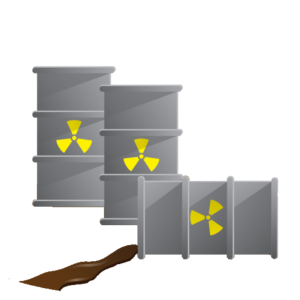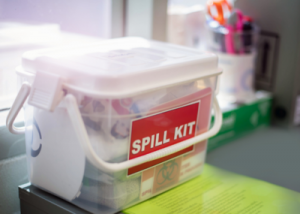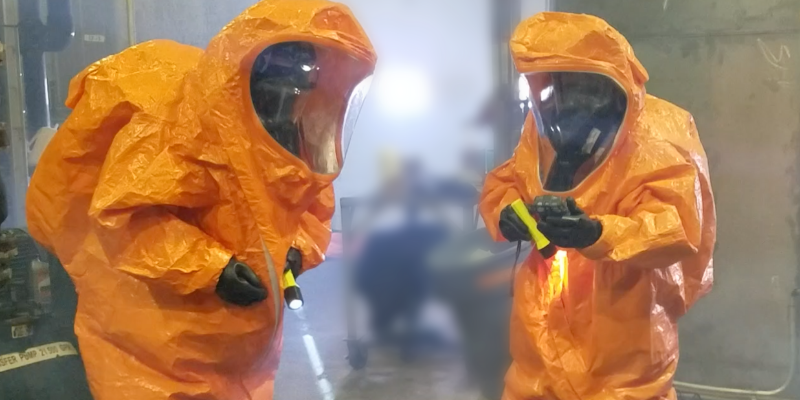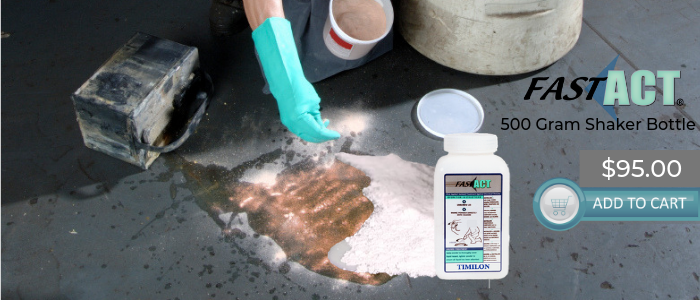Chemical spills can occur, and they can happen quickly, with little time to act in response to this incident. Depending on the environment, most spaces that contain the use or storing of hazardous chemicals must have a spill kit for chemical decontamination present for easy-to-use deployment. Laboratories, factories, and even schools that utilize potentially dangerous chemicals within their environment typically have in place chemical spill procedures and decontamination solutions at the ready to use, but are these currently used methods that they utilize for chemical decontamination the most efficient and useful solution?
There have been recent reports of many issues within chemical transportation and spills that have occurred from these sources of chemicals. If a spill occurs from this source, it can impact large areas and compromise the environment for those people exposed to the released chemical. When you are left dealing with larger spills such as from a transportation of chemicals, a traditional A-B-C Spill Kit will be hard to implement to decontaminate the chemicals – and thus they must be prepared for a chemical decontamination solution that can quickly assist during this large spill.
In this article we are going to discuss the different types of spill kits that are currently used for chemical decontamination and explore alternative methods of decontamination for chemical spills and releases.
What is a Chemical Spill
 Chemicals can be very useful for a broad array of different functions, however, there is also an inherent hazard to these chemicals, particularly when they are not properly controlled, or if an accident occurs such as a release or a spill of these chemicals. The use of chemicals is implemented in many workplaces from industrial plants, laboratories, agriculture, and even sometimes in office environments. When an incident occurs, however, resulting in a spill or release of the chemical into the environment it can lead to significant effects to the environment and to the health of those exposed to this released chemical.
Chemicals can be very useful for a broad array of different functions, however, there is also an inherent hazard to these chemicals, particularly when they are not properly controlled, or if an accident occurs such as a release or a spill of these chemicals. The use of chemicals is implemented in many workplaces from industrial plants, laboratories, agriculture, and even sometimes in office environments. When an incident occurs, however, resulting in a spill or release of the chemical into the environment it can lead to significant effects to the environment and to the health of those exposed to this released chemical.
There are two different classified types of chemical spills, minor (simple) spills and major (complicated) spills. A minor spill is one that a person can easily clean-up such as a non-hazardous chemical that is spilled onto the floor. These spills are typically small, confined, and present minimal hazards within the environment. A major chemical spill will usually result in the immediate evacuation of the area, and potentially the whole affected building. This will be the result of a hazardous chemical that is spilled in large quantities in the environment – this will be a high level of danger to those people exposed to this spill or release of chemicals.
What to do When a Chemical Spill Occurs
The release or spill of a chemical into the environment can be something that happens quickly and unexpectantly and will force individuals in the area to respond rapidly and most important, acting effectively to mitigate and decontaminate this chemical spill. If you are in an environment that stores and handles chemicals like a laboratory, there will be a specific list of procedures and guidelines set in place in the event that a chemical spill does occur unexpectantly. These procedures and guidelines will provide a detailed list of what to do during a chemical spill, and these procedures will also be accompanied by a stocked chemical spill kit that can be implemented to decontaminate the released chemical in the environment.
A spill kit is a chemical response kit that includes several different items that are needed to properly contain and clean up a chemical spill or release. There are a variety of different types of spill kits that are available for use in laboratories or other environments with chemicals. Chemical spill kits will contain multiple kinds of absorbents, pads, rolls, and mats to help contain smaller spills. Typically spill kits come in three different types, a universal kit, an oil-only kit, and a HAZMAT kit.
Where Should Spill Kits be Located?
The location in which a spill kit is stored and located is vital when responding to a chemical spill – as many times time is of the essence when the chemical is released. The items in a spill kit should be stored in a container that is large enough for the spill and is protected with the appropriate material. Chemical spill kits are ineffective if they are kept in an area that is not easily accessible such as in a remote area, in a hidden closet, or if the employees in the environment do not know where the kit is located. In reality, the ideal location for a spill kit is near an area where the chemicals are used and stored within the environment.
Methods of Decontamination
 When it comes to a chemical spill or release, there are many factors that you must consider before attempting the process of decontamination. There is a wide range of chemicals that are manufactured and used every day, and all of these chemicals will consist of a different chemical structure and will thus need to be identified to properly mitigate and decontaminate from the environment. Therefore, having some knowledge of the different chemicals that are used in your environment and knowing how to decontaminate each will help to efficiently and rapidly decontaminate the chemical. The use of chemical spill kits is among the most popular methods of decontamination, especially for small chemical spills. However, spill kits can provide some issues to the situation as well, as it will not cover all the necessary decontamination needs that are required for larger or more hazardous spills. Spill kits will not provide personal protective equipment (PPE), brooms, drain covers, and spill dikes that can be essential when responding to a chemical spill.
When it comes to a chemical spill or release, there are many factors that you must consider before attempting the process of decontamination. There is a wide range of chemicals that are manufactured and used every day, and all of these chemicals will consist of a different chemical structure and will thus need to be identified to properly mitigate and decontaminate from the environment. Therefore, having some knowledge of the different chemicals that are used in your environment and knowing how to decontaminate each will help to efficiently and rapidly decontaminate the chemical. The use of chemical spill kits is among the most popular methods of decontamination, especially for small chemical spills. However, spill kits can provide some issues to the situation as well, as it will not cover all the necessary decontamination needs that are required for larger or more hazardous spills. Spill kits will not provide personal protective equipment (PPE), brooms, drain covers, and spill dikes that can be essential when responding to a chemical spill.
How to Use Spill Kits for Chemicals
Chemical spill kits for unplanned and potentially dangerous chemicals can be used and implemented in certain situations such as a small chemical release of an unhazardous chemical, a small chemical release of a hazardous chemical, and any spill that can be easily cleaned up and decontaminated. If your environment does contain chemicals it is important to take inventory of these chemicals, the amount of them, and where they are located within this space.
After you have identified a chemical spill, you will need to go through the procedures to properly utilize a chemical spill kit. Evaluating the type of chemical that has been released into the environment is first and foremost, identifying the chemical will help to determine the best course of action in mitigating the chemical that was spilled. Arm yourself with the proper protective clothing gear to handle the situation. After you are protected with the right gear you can contain the liquid spill and stop the source of the spill, whether it was a seal drain or leak. Once the source has been stopped you can begin to clean-up the chemical and/or contact hazmat professionals to aid in the removal of the chemical – this will be the case when you are left with a large chemical spill of a classified hazardous chemical.
How to Respond to a Chemical Spill – FAST-ACT
A chemical spill can be in many different forms including gas, liquid, solid, fumes, dust, fibers, or vapors. The type of spill that is released can vary based on the environment and what type of chemical was spilled into the area. It will be hard to find a decontamination solution that can be effective against these different types of chemical spills, as a typical chemical spill kit will prove to be ineffective against a variety of these different chemical forms.
FAST-ACT (First Applied Sorbent Treatment – Against Chemical Threats) is a proprietary formulation of non-toxic nano-materials that are effective for neutralizing a wide range of toxic chemicals with the added capability to destroy chemical warfare agents. The FAST-ACT technology comes in a variety of different deployment mechanisms including pressurized cylinders and powder pails for an effective chemical decontamination of both liquid and vapor chemical threats.
FAST-ACT chemical decontamination products make it simple and effective to rapidly respond to a variety of chemical threats, with no need to identify the chemical before use which can help drastically to minimize the potential effects of the chemical spill in the environment. This is a critical component for hazmat and emergency response officials, as well as those employees who need to quickly respond to an unintentional chemical spill.



